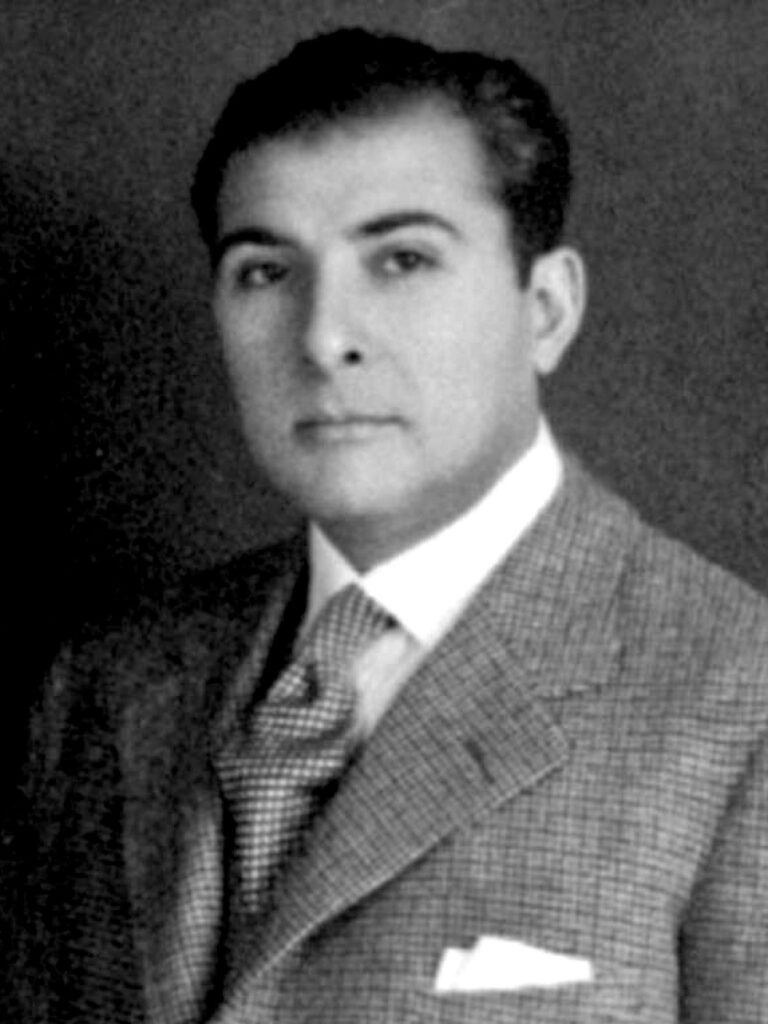Pablo Mirizzi

Pablo Luis Mirizzi (1893-1964) was an Argentinian surgeon.
Mirizzi is best known for his work in hepatobiliary surgery and the development of operative cholangiography. He graduated from the National University of Córdoba in 1915 and was awarded a government scholarship that allowed him to travel extensively across Europe and the United States, including study visits to the Mayo Clinic. These formative experiences shaped his surgical philosophy and inspired a lifelong dedication to precision, imaging, and the biliary tract.
Mirizzi was among the earliest to develop and promote intraoperative cholangiography, presenting his technique at the Third Argentine Congress of Surgery in 1931. His method provided real-time imaging of the bile ducts during surgery, allowing accurate detection of stones, anatomical variations, and strictures. The procedure, later referred to as “mirizzigraphy,” was a forerunner of modern-day cholangiographic protocols and earned him international recognition.
In 1948, Mirizzi published the landmark description of the syndrome that bears his name, Mirizzi syndrome, characterised by external compression of the common hepatic duct due to a gallstone lodged in the cystic duct or gallbladder infundibulum. Earlier references to the Mirizzi sign date back to 1942, when he observed impaired bile flow on operative cholangiograms. His legacy endures through the eponymous syndrome and his foundational contributions to biliary imaging and surgery, which remain clinically relevant in the diagnosis and management of complex gallstone disease.
Biographical Timeline
- Born on January 25, 1893 in Córdoba, Argentina.
- 1915 – Graduated as a physician from the National University of Córdoba, distinguished for academic excellence.
- Post-1915 – Awarded a government scholarship to study abroad. Traveled extensively through the U.S. and Europe visiting leading surgical centers, including the Mayo Clinic.
- 1926 – Appointed Professor of Surgical Clinic at the University of Córdoba at age 33.
- 1931 – Presented his landmark technique of intraoperative cholangiography at the Third Argentine Congress of Surgery. This innovation would become known internationally and is sometimes referred to as “mirizzigraphy”.
- 1940 – Described the condition later named Mirizzi Syndrome, involving extrinsic compression of the hepatic duct by an impacted gallstone.
- 1942 – Appointed Director of the Institute of Clinical Surgery in Córdoba.
- 1948 – Published the seminal paper officially identifying “Mirizzi Syndrome”.
- 1955 – Named Honorary Professor by the University of Córdoba.
- 1956 – Received the title of Master Surgeon from the Argentine Society of Surgeons.
- 1957 – Elected President of the International Congress of Surgery (held in Munich, 1959) by acclamation, a first for a Latin American surgeon.
- Died on August 28, 1964 of acute pulmonary oedema secondary to chronic heart failure at his home in Córdoba.
Medical Eponyms
Mirizzi Syndrome (1948)
Obstructive jaundice from extrinsic compression of the common hepatic duct by an impacted gallstone in the cystic duct or gallbladder neck.
1948 – Mirizzi formally described the syndrome in Journal International de Chirurgie, with further clarification in 1949. He emphasized compression without choledocholithiasis and used operative cholangiography to demonstrate the mechanism.
Subsequent classifications by McSherry (1982), Csendes (1989), and Beltrán (2008) expanded the syndrome into a spectrum involving cholecystobiliary and cholecystoenteric fistulae.
Mirizzi Sign (1942)
An early radiological observation of impaired hepatic duct drainage with retention of contrast during intraoperative cholangiography.
1942 – Mirizzi published El Sistema del Hepatico Su fisiopatología, where he explored bile flow regulation and suggested functional impairment due to an impacted stone, predating his formal syndrome description.
Mirizzigraphy
Term occasionally used (mostly in historical Latin American surgical literature) to describe operative cholangiography, reflecting Mirizzi’s pioneering work. This term has largely fallen out of common use but appears in regional surgical texts.
1932 – Mirizzi presented his operative cholangiography technique at the Third Argentine Congress of Surgery, making him one of the earliest advocates for intraoperative bile duct imaging.
Major Publications
- Mirizzi PL. La colangiografía durante las operaciones de las vías biliares. Comunicación en la Sociedad de Cirugía de Buenos Aires. 5 de octubre de 1932
- Mirrizzi PL. La Cholangiografía durante las operaciones de las vías biliares. Boletín y trabajos de la Sociedad de cirugía de Buenos Aires 1932; 16: 1133-1161
- Mirizzi PL. Le rôle du canal hépatique dans la physiologie de la voie biliaire excrétrice. Academie de Chirurgie de Paris 1938; 64: 1381-1387
- Mirizzi PL. Fisiopatología del hepato-colédoco. Colangiografía operatoria. Buenos Aires: El Ateneo. 1939
- Mirizzi PL. Physiologic sphincter of hepatic bile duct. Archives of Surgery 1940; 41: 1325-1333.
- Mirizzi PL. El Sistema del Hepatico* Su fisiopatología (The Muscular System of the Hepatic Duct). The Journal of the International College of Surgeons 1942; 5(4): 287-299
- Mirizzi PL. Síndrome de Conducto Hepático. Journal international de chirurgie. 1948; 8: 731–777.
- Mirizzi PL. Síndrome de Conducto Hepático. (Sindrome hepaticiano). Cirugía y Cirujanos 1949; 17(3): 111-133
- Mirizzi PL. Les fistules biliobiliares internes spontanées. Journal de Chirurgie. 1952; 68: 23–28
References
Biography
- Pablo Luis Mirizzi (1893-1964). Bull Soc Int Chir. 1964 Sep-Dec;23:479-81
- Coqui C. Parabienes para el medico argentino Dr. Pablo L. Mirizzi. Cir Cir. 1964; 32: 569-571.
- Etala E. Pablo L. Mirizzi. Prensa Med Argent. 1964 Oct 2;51:845-8.
- Leopardi LN, Maddern GJ. Pablo Luis Mirizzi: the man behind the syndrome. ANZ J Surg. 2007 Dec;77(12):1062-4.
- Martinez Marull A, Esteban Granero L. Pablo Luis Mirizzi. Acta Gastroenterol Latinoam. 2009 Sep;39(3):177-8
- Acerbi N. A 60 años de la muerte del Prof. Pablo Luis Mirizzi. Panteón familiar en el Cementerio San Jerónimo. Rev Fac Cien Med Univ Nac Cordoba. 2024 Sep 27;81(3):453-457
Eponymous terms
- Behrend A, Cullen ML. Cholecystocholedochal fistula, an unusual form of internal biliary fistula. Ann Surg. 1950 Aug;132(2):297-303.
- Csendes A, Díaz JC, Burdiles P, Maluenda F, Nava O. Mirizzi syndrome and cholecystobiliary fistula: a unifying classification. Br J Surg. 1989 Nov;76(11):1139-43.
- Pemberton M, Wells AD. The Mirizzi syndrome. Postgrad Med J. 1997 Aug;73(862):487-90.
- Beltran MA, Csendes A. Mirizzi syndrome and gallstone ileus: an unusual presentation of gallstone disease. J Gastrointest Surg. 2005 May-Jun;9(5):686-9.
- Beltrán MA, Csendes A, Cruces KS. The relationship of Mirizzi syndrome and cholecystoenteric fistula: validation of a modified classification. World J Surg. 2008 Oct;32(10):2237-43
- Beltrán MA. Mirizzi syndrome: history, current knowledge and proposal of a simplified classification. World J Gastroenterol. 2012 Sep 14;18(34):4639-50.
- Sanchez Garcia NL, Gordillo UP, Hernández Casas Y, Brismat Remedios I, Roger Morales DLT, et al. Diagnosis and Treatment of Mirizzi Syndrome: Case Report and Literature Review. Ann Gastroenterol Dig Syst 2020; 3(1): 1026.
- Klekowski J, Piekarska A, Góral M, Kozula M, Chabowski M. The Current Approach to the Diagnosis and Classification of Mirizzi Syndrome. Diagnostics (Basel). 2021 Sep 10;11(9):1660.
- Koo JGA, Tham HY, Toh EQ, Chia C, Thien A, Shelat VG. Mirizzi Syndrome-The Past, Present, and Future. Medicina (Kaunas). 2023 Dec 21;60(1):12
Eponym
the person behind the name
BM BCh, Oxford University. Currently training in Australia. Career interest in Hepatology and Emergency Medicine
BA MA (Oxon) MBChB (Edin) FACEM FFSEM. Emergency physician, Sir Charles Gairdner Hospital. Passion for rugby; medical history; medical education; and asynchronous learning #FOAMed evangelist. Co-founder and CTO of Life in the Fast lane | On Call: Principles and Protocol 4e| Eponyms | Books |

